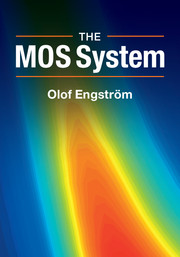Book contents
- Frontmatter
- Contents
- Preface
- 1 Introduction
- Part I Basic properties
- Part II Characterization techniques
- 6 Electrical characterization by Fermi-probe technique
- 7 Electrical characterization by thermal activation
- 8 Characterization of oxide/silicon energy band alignment: internal photoemission and X-ray photoelectron spectroscopy
- 9 Electron spin-based methods
- Part III Real MOS systems
- Index
- References
9 - Electron spin-based methods
from Part II - Characterization techniques
Published online by Cambridge University Press: 05 October 2014
- Frontmatter
- Contents
- Preface
- 1 Introduction
- Part I Basic properties
- Part II Characterization techniques
- 6 Electrical characterization by Fermi-probe technique
- 7 Electrical characterization by thermal activation
- 8 Characterization of oxide/silicon energy band alignment: internal photoemission and X-ray photoelectron spectroscopy
- 9 Electron spin-based methods
- Part III Real MOS systems
- Index
- References
Summary
Electron spin resonance
Basic principles
When a degenerate electronic energy level is exposed to perturbation by, for example, magnetic or electric fields, the degeneracy is removed and the level is split. Applying a magnetic field on atoms, a fine structure is found among their electron energy levels revealing this phenomenon and known as the Zeemann effect. A corresponding influence from an electric field exists and is labeled the Stark effect. Atomic orbitals are degenerate when populated by two electrons with opposite spin directions with quantum numbers +1/2 and –1/2, respectively. A magnetic field will align the magnetic moments resulting from the two spin directions into a parallel and antiparallel constellation. This gives rise to magnetic moments in opposite directions which makes the electron with positive spin increase its energy, while the negative spin lowers the energy of the other electron. By thermodynamic reasons when removing one of these electrons, the one left will adjust its spin to preferably occupy the lower of the two energy levels. It gives a possibility to study the system through excitations by photons and measure the absorption of photon intensity when exciting the single electron from the lower to the higher level. This is the physical base for spectroscopy by electron spin resonance (ESR). Since a material with single electron spins exhibits paramagnetic behavior, the technique is also labeled electron paramagnetic resonance (EPR). The two names are equally common in literature for designating the same characterization method (Poindexter and Caplan, 1983; Stesmans, 1993; Lenahan and Conley, 1998).
Information
- Type
- Chapter
- Information
- The MOS System , pp. 221 - 228Publisher: Cambridge University PressPrint publication year: 2014
